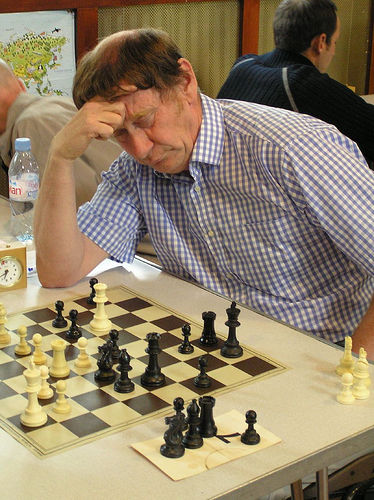
“Robert Ris (1988) is an International Master from Amsterdam. He has represented The Netherlands in various international youth events, but lately his playing activities are limited to league games.
Nowadays he is a full-time chess professional, focusing on teaching in primary schools, coaching talented youngsters and giving online lessons to students all around the world. He has recorded several well received DVDs for ChessBase.
Since 2015 he has been the organizer of the Dutch Rapid Championships. This is his third book for Thinkers Publishing, his first two on general chess improvement ‘Crucial Chess Skills for the Club Player‘, being widely appraised by the press and his audience.”

From the publisher via Amazon we have this blurb:
“The Sveshnikov is undeniably one of the most dynamic and aggressive Sicilians available these days. Most recently, it was made popular again by World Champion Magnus Carlsen in his match against Fabiano Caruana at the end of 2018.
The main lines lead to complex positions, and a deep knowledge and understanding of the opening is a real necessity for any player who wishes to enter this battlefield. Our author, Robert Ris, focuses on all the current developments, highlighting the most important and instructive games from recent years, using his own over-the board experiences.
Ris is well known for his theoretical knowledge and overall opening expertise. And we are quite convinced that he provides Sicilian players with an up-to date arsenal for playing the Sveshnikov. ”
End of blurb…
The author has had considerable experience with 5…e5 and here is one of his wins:
The Sveshnikov variation is described as one of the most aggressive and dynamic openings in the Sicilian defence.
The traditional “Lasker-Pelikan” starting position is:
and it does not seem that long ago that

was published followed by

Of the modern, elite players both Peter Leko and Vladimir Kramnik (to name but a few) have played the black side.
One of the consistent themes of the Sveshnikov is that White often doubles black’s pawns on the f-file and then tries to control d5 and make use of his queenside pawn majority. Also, Black often pushes his pawn to e4 and then uses the e5 square for a minor piece.
Following substantial work by Evgenny Sveshnikov and Gennadi Timoschenko we start the bulk of the analysis from the usual tabiya position:
In Part 1, Chapter 1 the author examines the dynamic line 9.Bxf6 gxf6 10.Nd5 f5 11.Bd3 Be6 12.Qh5
and this is looked at via a series of games where the players are generally very highly rated. Ris suggests that the queen move is probably premature and after 12…Rg8! black has a comfortable enough game. This judgement is demonstrated in the example email game Kele vs Fritsche, 2011 where black eventually wins:
The stronger 12.00 (the move I play) is given in Chapter 2 where play centers on 12…Bxd5 which in recent times have proved more popular than 12…Bg7 after which 13.exd5 Ne7 14.Nxb5!? winning a pawn is given. I played this line in a game vs Nigel Povah in 2015 which ended in a draw. Black plays 14…Bg7! and in the game we had 15.Nc3 e4 16.Bc4 00 when black has sufficient compensation for the pawn.
On move 14.c4 was played against Michael Krasenkow in his 2004 game v Gilberto Milos:
Again, Black is willing to sacrifice a queenside pawn but obtained strong play on the kingside.
However, 14.c3 remains the most popular move and White choses a more positional approach where his queen goes to h5 and his knight comes to c2. Alex Shirov chose this method in a game with Alexander Grischuk from Wijk aan Zee, 2003.
Since this book is written from Black’s point of view Black again wins.
Currently 14.Re1 is gaining in popularity and this is examined in Chapter 3.
The idea is to drop the bishop back to f1 and take some of the sting out of Black’s attack.
Part 2 discusses lines where White does not play 11.Bd3.
The famous knight sacrifice 11.Nxb5 is given as dubious whilst in the alternative bishop sacrifice 11.Bxb5 Black can play 11…axb5 12.Nb5 Bb7 sacrificing the exchange. This line is not for the faint hearted and they may prefer the older Ra4 treatment.
In chapter 7 the calmer 11.g3 is discussed: an interesting idea that is worth exploring and yet another approach in Chapter 8 is 11.exf5 Bf5 12.c3 and the knight will escape via c2.
Part 2 investigates 9.Nd5 the move Gary Kasparov preferred liked. After 9…Be7 and Black does not end up with doubled pawns.
Chapter 9 looks at 9…Be7 10.Nxe7 and the next chapter gives 10.Bxf6 which was the move Gary selected.
After 10…gxf6 11.c3 then Ne7 can be played followed by either 12.Nc2 or 12.Nf6+.
Chapter 12 looks at the earlier alternatives and the move 7.Nd5 is examined which is a line that has been far less popular than 7.Bg5 but with recent outings from Fabiano Caruana playing it several times against Magnus Carlsen I expect it to gain in popularity.
In Van Foreest v Carlsen the aggressive line 7 Nd5 8 ed5 Ne7 9 c4 Ng6 10 Qa4 Bd7 11 Qb4 Qb8 12 h4 black played 12…h5 and eventually won:
The book ends with some White choice oddities such as 6.Nf5 when 6…d5 is a strong reply and also 7.a4 but these moves do not seem to be a serious test of 5…e5.
I expect the Sveshnikov to increase in popularity in the next few years and this book should be a serious read for both White and Black players of the interesting positions.
Colin Lyne, Farnborough, Hampshire, 29th July, 2021

Book Details :
- Paperback : 336 pages
- Publisher: Thinkers Publishing; 1st edition (22 Sept. 2020)
- Language: English
- ISBN-10: 9492510839
- ISBN-13: 978-9492510839
- Product Dimensions: 16.51 x 2.03 x 22.86 cm
Official web site of Thinkers Publishing

